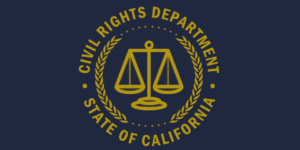Updated October 13, 2025
Sexual Harassment Lawsuits: Don't Miss Your Filing Deadline in California
Did you know that missing the statute of limitations on sexual harassment can permanently bar you from seeking justice? Unfortunately, many California employees lose their right to compensation simply because they waited too long to file.
Until recently, victims had just one year to report workplace sexual harassment in California. However, with the passage of Assembly Bill 9 (AB-9), this deadline has been extended to three years—giving survivors more time to come forward. Despite this positive change, many still miss critical filing deadlines because they don't understand the complex timing requirements.
The consequences of missing these deadlines are severe and irreversible. Courts strictly enforce time limits and will dismiss even the strongest cases if filed too late. Furthermore, different types of sexual harassment may affect how these deadlines apply to your specific situation.
This guide breaks down everything you need to know about sexual harassment filing deadlines in California, including the crucial three-year rule, exceptions that might extend your time to file, and steps to take immediately to protect your rights. Understanding these timeframes isn't just about legal compliance—it's about preserving your path to justice.
Understanding the Statute of Limitations in California
California law sets specific timeframes within which you must file sexual harassment claims. Failing to act within these periods typically means losing your right to seek justice entirely.
What is a statute of limitations?
A statute of limitations represents a legal time restriction that prohibits filing a claim after a specific deadline has passed. These time limits vary based on the type of case and jurisdiction . For California sexual harassment claims, these deadlines are particularly strict and enforced rigorously.
Statutes of limitations serve several critical purposes in our legal system. First, they ensure evidence remains fresh—paperwork can get lost, witnesses may forget details or become unavailable, and physical locations often change over time . Second, they encourage prompt reporting, which generally provides all parties with better access to evidence. Finally, they bring closure and finality to potential legal matters.
The general statute of limitations for personal injury claims in California is two years after the date of injury . Nevertheless, workplace sexual harassment claims follow different rules entirely.
Why the 3-year rule matters
The current statute of limitations for sexual harassment claims in California gives victims three years from the date of the harassment (or the most recent incident) to file a complaint with the California Civil Rights Department (CRD, formerly DFEH) . This extended timeframe represents a significant improvement for victims seeking justice.
Filing within this three-year window is crucial because it preserves your legal rights and ensures evidence remains as reliable as possible . Missing this deadline essentially bars you from pursuing any further legal action, regardless of how strong your case might otherwise be.
Additionally, after receiving a "right-to-sue" notice from the CRD, you have just one year to file a civil lawsuit . This creates a two-step timing process that many victims find confusing—which explains why some valid claims are dismissed solely due to missed deadlines.
The three-year rule particularly benefits those who need time to process their experiences or gather courage to come forward. Sexual harassment often causes significant trauma, making immediate reporting difficult for many victims.
How AB-9 changed the timeline
Prior to January 1, 2020, California employees had merely one year to file sexual harassment claims with the Department of Fair Employment and Housing (now CRD) . This restrictive timeframe often proved inadequate for victims still processing trauma or weighing their options.
Assembly Bill 9 (AB-9), also known as the Stop Harassment and Reporting Extension (SHARE) Act, dramatically changed this situation by tripling the filing period from one year to three years . While originally conceived to help sexual harassment victims specifically, the law applies broadly to all forms of workplace discrimination, harassment, and retaliation under the Fair Employment and Housing Act (FEHA) .
It's important to note that AB-9 does not revive claims that had already lapsed under the previous one-year statute of limitations . Consequently, if your harassment occurred before January 2020, the old one-year rule might still apply to your situation .
The extension significantly impacts employers as well, who now must preserve evidence and prepare for potential claims over a much longer period. During this extended timeline, witnesses might leave companies, memories may fade, or records could be destroyed—creating additional challenges for both sides .
For California employees experiencing workplace sexual harassment, understanding these timelines is not merely a legal technicality—it's the difference between having your day in court or losing your rights permanently.
Key Deadlines You Must Know
Navigating the complex system of deadlines for sexual harassment claims requires understanding multiple filing periods. Missing even one deadline can result in your case being dismissed, even if your evidence is compelling.
Filing with the California Civil Rights Department (CRD)
The first crucial deadline in California sexual harassment cases is the initial filing with the California Civil Rights Department. Since January 1, 2020, you must file your complaint with the CRD within three years of the date of the last incident of harassment . This extended timeframe replaced the previous one-year limitation, offering victims substantially more time to come forward.
When submitting your complaint, you'll need to complete an intake form detailing your experience. The CRD may then investigate your claim or issue an immediate right-to-sue notice at your request. Importantly, you must file this initial complaint even if you ultimately intend to pursue a lawsuit in civil court .
Right-to-sue letter and 1-year lawsuit deadline
Following your CRD filing, you'll eventually receive a "right-to-sue" letter. Once this letter arrives, a critical countdown begins. You have exactly one year from the date of receiving this notice to file your lawsuit in civil court . Failing to meet this deadline typically means permanent loss of your right to pursue legal action.
Remember that requesting an immediate right-to-sue letter means the CRD will not investigate your complaint . Although this allows you to proceed directly to court, most employment attorneys recommend obtaining this notice only if you already have legal representation, as navigating sexual harassment litigation without counsel is exceptionally challenging.
Federal EEOC deadlines vs California deadlines
Federal deadlines through the Equal Employment Opportunity Commission (EEOC) differ significantly from California's timeframes:
- EEOC standard deadline: 180 calendar days from the harassment
- Extended EEOC deadline: 300 calendar days in states with anti-discrimination laws (including California)
- CRD deadline: Three years from the date of harassment
When filing with the CRD, your complaint is often automatically cross-filed with the EEOC . Moreover, California's longer deadlines typically make it more advantageous to file under state law rather than federal law . This dual-filing system ensures you preserve your rights under both state and federal protections.
Special rules for government employees
Government employees face distinct deadlines that are typically much shorter than those for private-sector workers. Federal government employees must:
- Contact an EEO Counselor within 45 days of the harassment
- Attempt resolution through alternative dispute resolution
- If unsuccessful, file a formal complaint within 15 days of receiving notice from the EEO Counselor
Similarly, employees of California state or local government entities often must file a government tort claim within six months before pursuing other legal options . These accelerated timelines make it especially important for government employees to act swiftly after experiencing harassment.
Throughout the entire process, maintaining thorough documentation of all communications, preserving evidence, and consulting with an employment attorney can significantly strengthen your position when navigating these critical deadlines.
Types of Sexual Harassment That Affect Your Claim
Understanding the specific type of sexual harassment you've experienced is crucial for determining how the statute of limitations applies to your case. California law recognizes two distinct forms of sexual harassment, each with unique legal implications for your claim.
Quid pro quo harassment
Quid pro quo harassment occurs when someone in a position of authority demands sexual favors in exchange for employment benefits or to avoid negative consequences. The Latin phrase literally means "this for that," referring to the explicit or implicit exchange proposed. This type of harassment typically involves:
- A supervisor or authority figure making employment decisions based on submission to unwelcome sexual conduct
- Threatening termination, demotion, or other adverse actions if sexual advances are rejected
- Conditioning promotions, raises, or favorable assignments on sexual compliance
First and foremost, quid pro quo harassment requires the harasser to be in a supervisory position relative to the victim. In contrast to other forms of harassment, even a single incident can qualify as actionable quid pro quo harassment if the supervisor follows through on their threat or promise.
Hostile work environment
Hostile work environment harassment involves unwelcome sexual conduct creating an intimidating, offensive, or abusive workplace atmosphere. Unlike quid pro quo harassment, this form:
- Can be perpetrated by anyone in the workplace, including coworkers or even non-employees
- Requires behavior that is either severe or pervasive enough to alter working conditions
- Includes persistent sexual comments, inappropriate touching, displaying sexually explicit materials, or making sexual jokes
For a hostile work environment claim to be valid, the conduct must be both subjectively offensive to the victim and objectively offensive to a reasonable person in the victim's position. Indeed, courts apply both subjective and objective standards when evaluating these claims.
How the type of harassment impacts your timeline
The classification of harassment directly affects your claim's timeline and documentation requirements. Subsequently, this distinction influences how the statute of limitations is applied:
- For quid pro quo claims, the timeline typically begins when the supervisor carries out their threat or promise following rejection of sexual advances
- For hostile work environment claims, determining the starting point can be more complex as the harassment often occurs over time
Notably, for hostile work environment cases, the "continuing violations doctrine" may apply, potentially extending your filing deadline by treating ongoing harassment as a single continuing violation rather than separate incidents. This doctrine often makes the statute of limitations more flexible for hostile work environment claims.
As a result, accurately identifying and documenting the specific type of harassment you experienced is essential for preserving your legal rights and meeting filing deadlines.
Exceptions That May Extend Your Filing Deadline
Several legal doctrines exist that can extend your filing deadlines in sexual harassment cases, even after the standard statute of limitations appears to have expired. These exceptions provide crucial pathways for justice in complex situations.
The continuing violations doctrine
The continuing violations doctrine allows liability for unlawful employer conduct occurring outside the statute of limitations if sufficiently connected to unlawful conduct within the limitations period . This powerful legal concept particularly applies to hostile work environment claims where harassment occurs repeatedly over time.
In 2001, the California Supreme Court established a three-part test to determine this connection:
- The actions must be sufficiently similar in kind
- They must occur with sufficient frequency
- They must not have acquired a degree of permanence indicating further efforts to end the conduct would be futile
Accordingly, if at least one act of harassment falls within the three-year filing period, you may potentially include earlier incidents as part of your claim . This doctrine effectively "stops the clock" from running until either the harassment ends or you reasonably believe further complaints would be futile .
Equitable tolling and estoppel
Equitable tolling temporarily suspends the statute of limitations under specific circumstances . This exception may apply whenever:
- You and the employer sign a tolling agreement
- The employer concealed violations, leaving you unaware
- An administrative agency is actively investigating your case
Whereas equitable tolling pauses the clock, estoppel prevents an employer from using the statute of limitations as a defense when their actions misled you . Codified in California Evidence Code section 623, estoppel requires four elements: the employer knew the facts, intended their conduct to be acted upon, you were ignorant of the true facts, and you relied on their conduct to your detriment .
Childhood sexual abuse extensions
For survivors of childhood sexual abuse, California has enacted substantial extensions. Assembly Bill 218 created a three-year "lookback window" from January 1, 2020, to December 31, 2022, allowing previously time-barred claims to proceed regardless of when the abuse occurred .
Even though this window has closed, survivors may still file under the extended statute of limitations until age 40 or within five years of discovering the psychological effects of the abuse . Furthermore, as of January 2024, California eliminated the statute of limitations entirely for newly filed child sexual assault lawsuits, though this change is not retroactive .
AB 2777 provides additional protections for adult survivors, creating a four-year lookback window (2023-2026) for sexual assault claims that occurred on or after January 1, 2009 . Yet, this revival does not apply to previously litigated or settled claims .
How to Strengthen Your Case Before Time Runs Out
Taking immediate action to gather and organize evidence is crucial for building a strong sexual harassment case. As the statute of limitations clock ticks, your proactive efforts can make the difference between success and dismissal.
Start collecting evidence early
Acting quickly to preserve evidence strengthens your position substantially. Begin by saving all relevant communications:
- Emails, text messages, voicemails, and workplace messaging app conversations
- Photos of inappropriate materials or physical evidence
- Performance evaluations, especially those showing changes after rejecting advances
- Medical or therapy records demonstrating emotional impact
Store evidence securely on personal devices or cloud storage—not company computers—as workplace access might be revoked if you file a complaint . Remember that evidence collected at the time of incidents carries significantly more weight than retrospective accounts .
Document everything in a timeline
Create a detailed chronological record of each incident. In your documentation, include:
- Date, time, location, and specific details of what occurred
- Names of people involved and potential witnesses
- Your emotional and physical reactions
- Any reporting attempts and company responses
Use a simple format with consistent categories for each entry . This organized approach establishes patterns of behavior that strengthen your case considerably.
Seek legal help to avoid missing deadlines
Consulting with an employment attorney promptly is vital—ideally before making formal reports . Early legal guidance helps:
- Navigate both state and federal filing requirements
- Preserve appropriate evidence effectively
- Avoid inadvertently weakening your case through problematic communications
- Ensure all critical deadlines are met
Effective evidence collection directly impacts the strength of your case. Starting this process immediately after harassment occurs—not when you decide to take legal action—provides the strongest foundation for seeking justice .
Conclusion
Sexual harassment claims demand swift action, especially given the strict deadlines California law imposes. Therefore, understanding the three-year statute of limitations stands as your first line of defense against losing your right to seek justice. This extended timeline certainly represents progress, yet many victims still miss critical filing periods because they remain unaware of these crucial deadlines.
Time restrictions serve important purposes within our legal system. Nevertheless, they can create substantial barriers for harassment victims still processing trauma. Above all, remember that once these deadlines pass, even the strongest cases face automatic dismissal regardless of merit.
Additionally, different harassment types affect how these limitations apply to your situation. Quid pro quo incidents often have clearer timelines, while hostile work environment claims might qualify for extensions under the continuing violations doctrine. Still, exceptions like equitable tolling remain narrow and should never be relied upon as your primary strategy.
Taking immediate action significantly improves your chances of success. Document all incidents promptly, preserve communications, and create detailed timelines of events. Subsequently, consult with an employment attorney who can guide you through the complex filing requirements before deadlines approach.
Sexual harassment causes lasting harm that deserves legal remedy. Filing within prescribed timeframes ensures your voice will be heard and your rights protected. Though navigating these legal requirements may seem daunting, understanding these critical deadlines represents your essential first step toward seeking justice and accountability.
References
[1] – https://www.melmedlaw.com/guide/what-type-of-evidence-does-a-plaintiff-need-to-support-a-claim-of-sexual-harassment-in-the-workplace/
[2] – https://calcivilrights.ca.gov/wp-content/uploads/sites/32/2020/03/Sexual-Harassment-Fact-Sheet_ENG.pdf
[3] – https://rdlawgroup.com/blog/what-are-the-3-most-critical-deadlines-for-filing-a-sexual-harassment-claim-in-los-angeles/
[4] – https://eldessoukylaw.com/blog/sexual-harassment-statute-of-limitations-california/
[5] – https://rdlawgroup.com/blog/how-much-time-do-i-have-to-file-a-sexual-harassment-claim-in-los-angeles-understanding-californias-strict-deadlines/
[6] – https://calcivilrights.ca.gov/complaintprocess/
[7] – https://www.hr.law/blog/california-employee-lawsuit-steps-to-take-when-filing-sexual-harassment-claims/
[8] – https://calcivilrights.ca.gov/obtainrighttosue/
[9] – https://www.eeoc.gov/sexual-harassment
[10] – https://www.eeoc.gov/time-limits-filing-charge
[11] – https://daltonemploymentlaw.com/whats-the-statute-of-limitations-on-sexual-harassment-at-work/
[12] – https://www.kingsleykingsley.com/employment-lawyer/sexual-harassment/statute-of-limitations
[13] – https://calemploymentlawupdate.proskauer.com/2020/09/continuing-violation-theory-saves-employees-sexual-harassment-claim/
[14] – https://www.kingsleykingsley.com/blog/2020/january/continuing-violation
[15] – https://ebachmanlaw.com/how-the-continuing-violation-doctrine-can-help-your-employment-discrimination-case/
[16] – https://rezlaw.com/statute-limitations-employment-law-claims/
[17] – https://bc-llp.com/equitable-estoppel-in-california/
[18] – https://www.zalkin.com/child-sexual-abuse/california-ab-218/
[19] – https://www.amglaw.com/blog/2024/01/california-takes-big-step-to-support-child-sexual-abuse-survivors-in-2024/
[20] – https://daalaw.com/blog/your-rights-under-californias-sexual-abuse-statute-extension-law/
[21] – https://www.makaremlaw.com/blog/2025/09/how-to-document-workplace-sexual-harassment-in-los-angeles-evidence-for-your-case/
If you need workplace harassment litigation, please call Setyan Law at (213)-618-3655. Free consultation.






